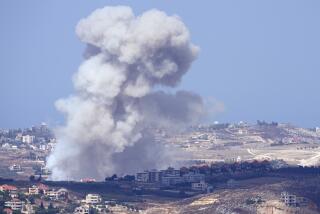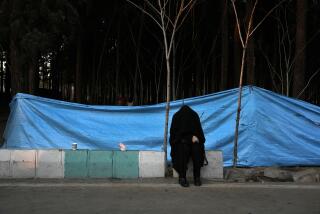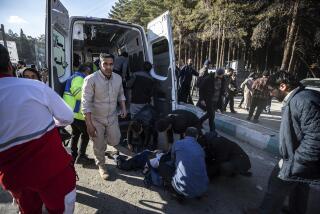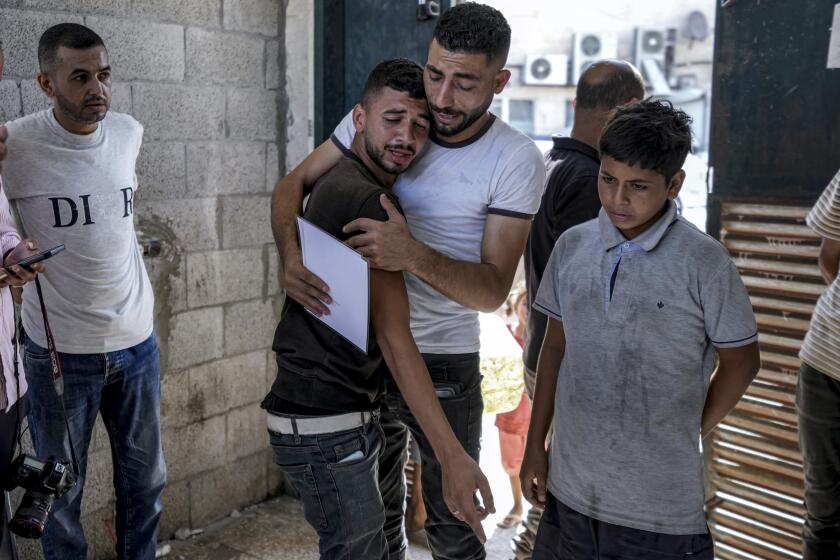Death Toll in Twin Strikes on Iraqi Shiites Rises to 143
BAGHDAD — In the worst day of bloodshed in Iraq since the fall of Saddam Hussein, the death toll rose to at least 143 Tuesday from synchronized suicide bombings of Shiite Muslim targets that seemed designed to inflict maximum casualties and inflame sectarian tensions.
The explosions here and in the holy city of Karbala tore into throngs of Shiite pilgrims, spattering the walls of venerated shrines with blood and body parts. The attacks took place on the peak day of the Ashura feast, the holiest Shiite holiday period. More than 430 people were wounded, and the number of dead from bombs packed with ball bearings to wreak destruction at close range seemed likely to increase.
The choreographed attacks were blamed by Iraqi and U.S. officials on Abu Musab Zarqawi, a Jordanian fugitive affiliated with Al Qaeda. But the officials offered little proof that the alleged terrorist, who they believe is targeting Shiites in an effort to foment civil strife, was behind the bombings.
Potential suspects also include other Islamic extremists and Iraqi Sunni Muslims who prospered during the Hussein regime and are fearful of losing privilege.
The magnitude and savagery of the attacks dealt a devastating psychological blow to the Shiite community, which represents 60% of Iraq’s population and has asserted new clout after decades of repression.
The apparent ease of the attacks underscored Iraq’s vulnerability as the U.S. military relinquishes security duties to overmatched Iraqi police.
“How can you combat this?” said police Capt. Sabah Mohammed, his AK-47 at the ready as frightened pilgrims fled through the narrow streets of Karbala after the blasts. “How can you combat one person who wants to blow himself up among thousands of people?”
Last month, suicide bombers killed more than 100 people in attacks on Kurdish political party offices in the northern city of Irbil. Kurds also were repressed under Hussein and aspire to greater autonomy, so attacking them could be seen as part of a strategy to destabilize Iraq.
In Baghdad on Tuesday, three suicide bombers struck about 10 a.m. after blending in with worshipers packed into a gold-domed shrine in the Kadhimiya neighborhood. The men set off explosives-laden vests that shredded the crowd with shrapnel, blew a massive wooden door off its hinges and littered a courtyard with mangled corpses and bloodied shoes that the faithful had stored on shelves at the entrance of the prayer area.
“The keepers of the shoes were killed,” said Hussein Hamid, a leader of a Shiite militia, as black-garbed gunmen sorrowfully thumped their heads and chests. “We found children decapitated, a woman with no face. Look, those are people on the ground. What’s left of them.”
Hamid displayed a fragment of a grenade he found amid the devastation, suggesting that the bombers either had grenades strapped to their vests or hurled some before blowing themselves up, authorities said.
Iraqi police captured a fourth bomber whose vest failed to explode. The man threw grenades at panicked pilgrims before he was subdued, said an Iraqi police commander who identified himself as Ali. Authorities disclosed no information about the suspect.
The Baghdad explosions killed 58 and wounded 200, officials said.
About the same time, a second attack team struck in the historic center of Karbala, where hundreds of thousands of Shiite pilgrims had gathered to commemorate the martyrdom of the revered 7th century Imam Hussein, the prophet Muhammad’s grandson.
U.S. authorities described a combination of methods: suicide bombing, a remote-controlled explosive and mortars fired from the outskirts of the city.
A U.S. Army spokesman said one suicide bomber was involved, but Iraqi police and eyewitnesses said suicide bombers caused most of the seven or eight blasts. Iraqi police downplayed the reports of mortar strikes.
The site of the first blast in Karbala was just outside a security cordon at the shrine of Imam Hussein. A bearded bomber dressed in a black outfit similar to that of the pilgrims waded into a group of chanting men, police officer Khalid Ali said.
The explosion killed and maimed more than a dozen worshipers. Streets became gantlets as stampeding crowds ran headlong into new explosions.
Police recovered the head of the bomber for forensic analysis, Ali said. Officers also rounded up six suspected accomplices. There were unconfirmed reports that mobs lynched three other suspects, a U.S. official said. The Karbala attacks killed at least 85 and wounded 233.
Iraqi leaders and U.S. officials immediately branded alleged Al Qaeda associate Zarqawi as the mastermind of Tuesday’s carnage. The coordinated strikes were consistent with his methods, officials said.
“The only way Zarqawi can operate is through inciting violence and driving a sectarian war in this country,” said Mouwafak Rabii, a moderate Shiite member of the Iraqi Governing Council. “But I can tell you one thing, that he’s going to fail. Thank goodness, Iraqi people are very aware of his evil intentions.”
Zarqawi is a “chief suspect” because “suicidal, spectacular, symbolic” attacks are his trademark, said Brig. Gen. Mark Kimmitt, a military spokesman.
“All of this would point to some kind of transnational organization,” Kimmitt said. He added that the plotters were “probably a mixture of both” Iraqis and foreigners.
But some say the U.S. emphasis on Zarqawi oversimplifies an insurgency that includes die-hard Hussein loyalists and Iraqi fundamentalists.
U.S. officials again cited a recently seized letter they say Zarqawi wrote that describes a plan to target Shiites.
Hard-line Shiite leaders agreed that the culprits behind the bombings want to exploit escalating tensions between the Shiite majority and Sunnis, the former elite of the now-defunct Baathist party. Although Shiites referred to the Zarqawi letter, they did not single him out as the top suspect.
“It is our opinion that the perpetrators are fundamentalists with logistical support from remnants of the Baath,” said Abdelaziz Hakim, a Governing Council member and leader of the Supreme Council for Islamic Revolution in Iraq, a Shiite party.
The ordnance recovered from Tuesday’s bombings resembled bomb components used last month in Irbil, where a duo of suicide attackers killed 109 people at Kurdish political party offices, Hakim told reporters.
Tuesday’s mayhem, the deadliest of the more than 20 mass-casualty attacks since the fall, had a grimly predictable quality. The U.S. military, the Iraqi police and Shiite militias had all gone on alert during the Ashura holiday because of attackers’ penchant for symbolism. The streets of Baghdad emptied Monday night.
But the crush of humanity led to security lapses in both cities.
Visitors entering the shrine areas were technically subject to body searches by Shiite militia guards, but that largely amounted to a quick pat-down. Smuggling in small amounts of explosives would not have been difficult, officials in Karbala said.
Searches are considered intrusive in Iraq, with its tradition of Arab hospitality. In Karbala, many pilgrims traveled from around the country or neighboring Iran, taking advantage of the abolition of Hussein-era bans on cross-border pilgrimages.
“These people are visitors, and we feel strange to be searching them,” one police official said.
Guards acknowledge that there were lapses at the Kadhimiya shrine. Police and armed Shiite militiamen, who exercise stern control in the tight-knit neighborhood, described a lack of coordination as well. Clashes between Shiite guards and police officers resulted partly from Shiite-Sunni tensions, both sides said.
The Shiite guards “wanted to be alone here and take charge of everything,” a policeman named Abo Ali said. “Maybe they consider the police to be related to the previous regime. They were so offensive. So we withdrew and started controlling things at the entrances to the neighborhood.”
The U.S. military was deeply involved in preparing the defenses for the shrine area in Baghdad, but it stuck to a new approach of ceding a primary role to the Iraqi police, Kimmitt said. Moreover, the U.S. troops took pains to respect the holy rituals by keeping their distance.
Iraqi police will take the lead in the complex task of investigating the two attacks, despite their inexperience and limited forensic technology.
In the emotional aftermath of the attacks, some Shiites blamed the U.S. for failing to protect them, and in the most extreme cases, accused the Americans of staging the attacks.
Shiite leader Hakim struck a far more moderate tone toward the U.S. But he suggested that the shift of responsibility to Iraqi security forces leaves the country with the worst of both worlds.
“The occupiers should be held responsible for not taking the necessary precautions in order to prevent such terrorism, and at the same time not letting the Iraqi people take security matters into our own hands,” he said.
*
(BEGIN TEXT OF INFOBOX)
Iraq bombings
Some of the deadly sectarian attacks in Iraq since the war began last year:
* March 2: A series of coordinated blasts strike Shiite Muslim shrines in the southern city of Karbala and in Baghdad as thousands of pilgrims converge for a major festival, killing at least 143 people and wounding hundreds.
* Feb. 1: Twin suicide bombings kill 109 people at two Kurdish political party offices in the northern city of Irbil.
* Nov. 20: A truck bomb explodes near a Kurdish party office in northern oil city of Kirkuk, killing five people and wounding 30. Local officials blame Islamic extremists linked to the Al Qaeda terrorist network.
* Aug. 29: A car bomb explodes outside a shrine in the Shiite Muslim holy city of Najaf, killing 121 people, including Shiite cleric Ayatollah Mohammed Bakr Hakim.
Source: Associated Press
More to Read
Sign up for Essential California
The most important California stories and recommendations in your inbox every morning.
You may occasionally receive promotional content from the Los Angeles Times.









